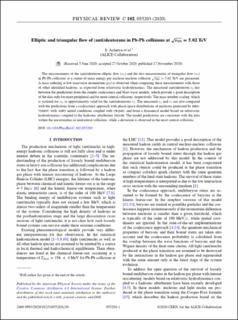Elliptic and triangular flow of (anti)deuterons in Pb-Pb collisions at √sNN=5.02 TeV
Acharya, Shreyasi; Adamová, Dagmar; Adler, Alexander; Adolfsson, Jonatan; Aggarwal, Madan M.; Aglieri Rinella, Gianluca; Agnello, Michelangelo; Agrawal, Nikita; Ahammed, Zubayer; Ahmad, Shafiq F.; Alme, Johan; Altenkaemper, Lucas; Djuvsland, Øystein; Eikeland, Viljar Nilsen; Ersdal, Magnus Rentsch; Fionda, Fiorella Maria Celeste; Grøttvik, Ola Slettevoll; Lofnes, Ingrid Mckibben; Nystrand, Joakim; Rehman, Attiq Ur; Røhrich, Dieter; Tambave, Ganesh Jagannath; Ullaland, Kjetil; Wagner, Boris; Yang, Shiming; Yuan, Shiming; Zhou, Zhuo; Arsene, Ionut Cristian; Dordic, Olja; Lardeux, Antoine Xavier; Mahmood, Sohail Musa; Malik, Qasim Waheed; Neagu, Alexandra; Richter, Matthias; Røed, Ketil; Skaali, Toralf Bernhard; Tveter, Trine Spedstad; Wikne, Jon Christopher; Helstrup, Håvard; Hetland, Kristin Fanebust; Kileng, Bjarte; Nesbø, Simon Voigt; Storetvedt, Maksim Melnik; Langøy, Rune; Lien, Jørgen André; Ahn, Sang Un; Akbar, Zaenai; Akindinov, Alexander; Al-Turany, Mohammed; Alam, Sk Noor; ALICE, Collaboration
Journal article, Peer reviewed
Published version

Åpne
Permanent lenke
https://hdl.handle.net/11250/2758179Utgivelsesdato
2020-11-17Metadata
Vis full innførselSamlinger
Sammendrag
The measurements of the (anti)deuteron elliptic flow (v2) and the first measurements of triangular flow (v3) in Pb-Pb collisions at a center-of-mass energy per nucleon-nucleon collision √sNN = 5.02 TeV are presented. A mass ordering at low transverse momentum (pT) is observed when comparing these measurements with those of other identified hadrons, as expected from relativistic hydrodynamics. The measured (anti)deuteron v2 lies between the predictions from the simple coalescence and blast-wave models, which provide a good description of the data only for more peripheral and for more central collisions, respectively. The mass number scaling, which is violated for v2, is approximately valid for the (anti)deuterons v3. The measured v2 and v3 are also compared with the predictions from a coalescence approach with phase-space distributions of nucleons generated by iebe-vishnu with ampt initial conditions coupled with urqmd, and from a dynamical model based on relativistic hydrodynamics coupled to the hadronic afterburner smash. The model predictions are consistent with the data within the uncertainties in midcentral collisions, while a deviation is observed in the most central collisions.
